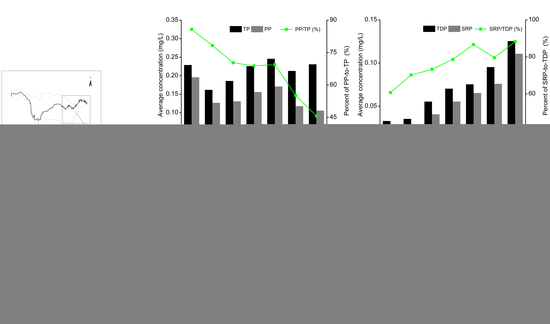Distribution Characteristics and Spatial Differences of Phosphorus in the Main Stream of the Urban River Stretches of the Middle and Lower Reaches of the Yangtze River
Abstract
1. Introduction
2. Sampling, Testing and Data Analysis
2.1. Sampling Sites and Sample Collection
2.2. Sample Measurement
2.3. Data Collection and Analysis
3. Results and Discussion
3.1. Water Physicochemical Properties
3.2. Distribution Characteristics of Phosphorus in the Main Urban River Stretches
3.2.1. Distribution of TP, PP, and Percent of PP to TP
3.2.2. Distribution of TDP, SRP, and Percent of SRP to TDP
3.2.3. Effect of Phosphorus Distribution on Water Eutrophication
3.3. The Impact of Cities on Phosphorus Distribution
3.4. Spatial Differences of Phosphorus
3.4.1. PP and SRP in Surface and Bottom Layer Water
3.4.2. PP and SRP in the Left and Right Shores and the Central Line of Urban Lower Reaches
3.5. The Possible Changes in PP and SRP under the Current Situation
3.5.1. The Possible Changes of PP
3.5.2. The Possible Changes in SRP
4. Conclusions and Suggestions
- (1)
- Based on onsite data analysis in June 2014, the average PP changed from 0.195 mg/L to 0.105 mg/L from WH to SH, and the average PP-to-TP ratio decreased from 85.71% in WH to 45.65% in SH, which showed a gradual decrease, while the average SRP changed from 0.033 to 0.125 mg/L, and the average SRP-to-TDP ratio increased from 60.73% in WH to 88.28% in SH, showing a gradual upward trend. In general, PP was still the principal form of TP in the middle and lower reaches of the Yangtze River; however, the PP-to-TP ratio had a decreasing trend compared with that of historical data.
- (2)
- Overall, the average PP and SRP concentrations of the lower reach of each city were relatively higher than those of the upper reach, which was highly likely to be associated with the discharge of wastewater in urban river stretches along the Yangtze River Basin. Therefore, phosphorus emissions of municipal wastewater treatment plants should also be monitored and analyzed in the main urban river stretches, and the water environmental capacity of phosphorus of the main urban river stretches would also need to be calculated and analyzed to strictly control phosphorus emissions of urban river stretches along the middle and lower reaches of the Yangtze River.
- (3)
- Actual monitoring data showed that the concentrations of the PP and SRP of different sampling locations and water depths in same monitoring section showed differences. As a result, the phosphorus concentration of the sampling point did not represent the phosphorus concentration of the monitoring section. Therefore, the phosphorus flux of the monitoring section needs to be monitored.
- (4)
- Combined with an evaluation of long-term monitoring data and field surveys, the SRP had an increasing tendency on the whole. The risk of water eutrophication was not optimistic, especially in the Yangtze River estuary, the riparian zone of the urban river stretches, the tributary slow-flowing river section and in the corresponding naturally connected lakes. Therefore, the research in the middle and lower reaches of the Yangtze River should focus on strengthening the emergency monitoring and rapid warning of phosphorus pollution in sensitive areas.
Author Contributions
Funding
Acknowledgments
Conflicts of Interest
References
- CWRC (Changjiang Water Resource Commission). The Comprehensive Planning of the Yangtze River Water Resources; Changjiang Press: Wuhan, China, 2008. (In Chinese) [Google Scholar]
- Duan, S.; Liang, T.; Zhang, S.; Wang, L.; Zhang, X.; Chen, X. Seasonal changes in nitrogen and phosphorus transport in the lower Changjiang River before the construction of the Three Gorges Dam. Estuar. Coast. Shelf Sci. 2008, 79, 239–250. [Google Scholar] [CrossRef]
- Sun, C.; Shen, Z.; Liu, R.; Xiong, M.; Ma, F.; Zhang, O. Historical trend of nitrogen and phosphorus loads from the upper Yangtze River basin and their responses to the Three Gorges Dam. Environ. Sci. Pollut. Res. 2013, 20, 8871–8880. [Google Scholar] [CrossRef] [PubMed]
- Tang, X.; Wu, M.; Li, R. Distribution, sedimentation, and bioavailability of particulate phosphorus in the mainstream of the Three Gorges Reservoir. Water Res. 2018, 140, 44–55. [Google Scholar] [CrossRef] [PubMed]
- Tang, X.; Wu, M.; Li, R. Phosphorus distribution and bioavailability dynamics in the mainstream water and surface sediment of the Three Gorges Reservoir between 2003 and 2010. Water Res. 2018, 145, 321–331. [Google Scholar] [CrossRef] [PubMed]
- Jin, X.; Wang, S.; Bu, Q.; Wu, F. Laboratory Experiments on Phosphorous Release from the Sediments of 9 Lakes in the Middle and Lower Reaches of Yangtze River Region, China. Water Air Soil Pollut. 2006, 176, 233–251. [Google Scholar] [CrossRef]
- Jin, X.C.; Wang, S.R.; Chu, J.Z.; Wu, F.C. Organic Phosphorus in Shallow Lake Sediments in Middle and Lower Reaches of the Yangtze River Area in China. Pedosphere 2008, 18, 394–400. [Google Scholar] [CrossRef]
- Wu, P.; Qin, B.; Yu, G. Estimates of long-term water total phosphorus (TP) concentrations in three large shallow lakes in the Yangtze River basin, China. Environ. Sci Pollut Res. Int. 2016, 23, 4938–4948. [Google Scholar] [CrossRef]
- Liu, R.; Chen, Y.; Sun, C.; Zhang, P.; Wang, J.; Yu, W. Uncertainty analysis of total phosphorus spatial-temporal variations in the Yangtze River Estuary using different interpolation methods. Mar. Pollut Bull. 2014, 86, 68–75. [Google Scholar] [CrossRef]
- Zhou, J.; Zhang, M.; Lu, P. The effect of dams on phosphorus in the middle and lower Yangtze river. Water Resour Res. 2013, 49, 3659–3669. [Google Scholar] [CrossRef]
- CWRC (Changjiang Water Resource Commission). Changjiang Sediment: Bulletin; Changjiang Press: Wuhan, China; pp. 2010–2017. (In Chinese)
- CWRC (Changjiang Water Resource Commission). Water Resources Bulletin of the Yangtze River Basin and the Southwestern Rivers; Changjiang Press: Wuhan, China, 2005–2017. (In Chinese) [Google Scholar]
- Han, C.N.; Zheng, B.H.; Qin, Y.W.; Ma, Y.Q.; Yang, C.C.; Liu, Z.C.; Cao, W.; Chi, M.H. Impact of upstream river inputs and reservoir operation on phosphorus fractions in water-particulate phases in the Three Gorges Reservoir. Sci. Total Environ. 2018, 610, 1546–1556. [Google Scholar] [CrossRef]
- Heffernan, J.; Barry, J.; Devlin, M.; Fryer, R. A simulation tool for designing nutrient monitoring programmes for eutrophication assessments. Environmetrics 2010, 21, 3–20. [Google Scholar] [CrossRef]
- King, K.W.; Balogh, J.C.; Agrawal, S.G.; Tritabaugh, C.J.; Ryan, J.A. Phosphorus concentration and loading reductions following changes in fertilizer application and formulation on managed turf. J. Environ. Monit. 2012, 14, 2929–2938. [Google Scholar] [CrossRef] [PubMed]
- Huang, J.; Wang, X.; Xi, B.; Xu, Q.; Tang, Y.; Jia, K. Long-term variations of TN and TP in four lakes fed by Yangtze River at various timescales. Environ. Earth Sci. 2015, 74, 3993–4009. [Google Scholar] [CrossRef]
- Huang, Q.; Shen, H.; Wang, Z.; Liu, X.; Fu, R. Influences of natural and anthropogenic processes on the nitrogen and phosphorus fluxes of the Yangtze Estuary, China. Reg. Environ. Chang. 2006, 6, 125–131. [Google Scholar] [CrossRef]
- Sonzogni, W.C.; Chapra, S.C.; Armstrong, D.E.; Logan, T.J. Bioavailability of PhosphorusI nputs to Lakes. J. Environ. Qual. 1982, 11, 555–563. [Google Scholar] [CrossRef]
- Ellison, M.E.; Brett, M.T. Particulate phosphorus bioavailability as a function of stream flow and land cover. Water Res. 2006, 40, 1258–1268. [Google Scholar] [CrossRef]
- Shen, Z. Phosphorus and Silicate Fluxes in the Yangtze River. Acta Oceanol. Sin. 2006, 61, 741–751. [Google Scholar]
- Duan, S.; Zhang, S.; Chen, X.; Zhang, X.; Wang, L.; Yan, W. Concentrations of nitrogen and phosphorus and nutrient transport to estuary of the Yangtze River. Environ. Sci. 2000, 21, 53–57. (In Chinese) [Google Scholar]
- Xu, K.; Hayashi, S.; Murakami, S.; Maki, H.; Xu, B.; Watanabe, M. Characteristics of Water Quality in the ChangjiangRiver: Observations Conducted in 1998 and 1999. Acta Geogr. Sin. 2004, 59, 118–124. [Google Scholar]
- Guo, L.; He, Q. Freshwater flocculation of suspended sediments in the Yangtze River, China. Ocean. Dynam. 2011, 61, 371–386. [Google Scholar] [CrossRef]
- Paerl, H.W.; Xu, H.; McCarthy, M.J.; Zhu, G.; Qin, B.; Li, Y. Controlling harmful cyanobacterial blooms in a hyper-eutrophic lake (Lake Taihu, China): The need for a dual nutrient (N & P) management strategy. Water Res. 2011, 45, 1973–1983. [Google Scholar] [PubMed]
- Xu, H.; Paerl, H.W.; Qin, B.; Zhu, G.; Gao, G. Nitrogen and phosphorus inputs control phytoplankton growth in eutrophic Lake Taihu, China. Limnol. Oceanogr. 2010, 55, 420–432. [Google Scholar] [CrossRef]
- Bergström, A.-K. The use of TN: TP and DIN: TP ratios as indicators for phytoplankton nutrient limitation in oligotrophic lakes affected by N deposition. Aquat. Sci. 2010, 72, 277–281. [Google Scholar] [CrossRef]
- Cao, X.; Wang, J.; Liao, J.; Sun, J.; Huang, Y. The threshold responses of phytoplankton community to nutrient gradient in a shallow eutrophic Chinese lake. Ecol. Indic. 2016, 61, 258–267. [Google Scholar] [CrossRef]
- Carstensen, J.; Klais, R.; Cloern, J.E. Phytoplankton blooms in estuarine and coastal waters: Seasonal patterns and key species. Estuar. Coast. Shelf Sci. 2015, 162, 98–109. [Google Scholar] [CrossRef]
- Paudel, B.; Velinsky, D.; Belton, T.; Pang, H. Spatial variability of estuarine environmental drivers and response by phytoplankton: A multivariate modeling approach. Ecol. Inform. 2016, 34, 1–12. [Google Scholar] [CrossRef]
- Kim, B.; Choi, K.; Kim, C.; Lee, U.H.; Kim, Y.H. Effects of the summer monsoon on the distribution and loading of organic carbon in a deep reservoir, Lake Soyang, Korea. Water Res. 2000, 34, 3495–3504. [Google Scholar] [CrossRef]
- Nie, Z.Y.; Liang, X.Q.; Xing, B.; Ye, Y.S.; Qian, Y.C.; Yu, Y.W. The current water trophic status in Tiaoxi River of Taihu Lake watershed and corresponding coping strategy based on N/P ratio analysis. Acta Ecol. Sin. 2012, 32, 44–55. [Google Scholar]
- Powers, S.M.; Bruulsema, T.W.; Burt, T.P. Long-term accumulation and transport of anthropogenic phosphorus in three river basins. Nat. Geosci. 2016, 9, 353–356. [Google Scholar] [CrossRef]
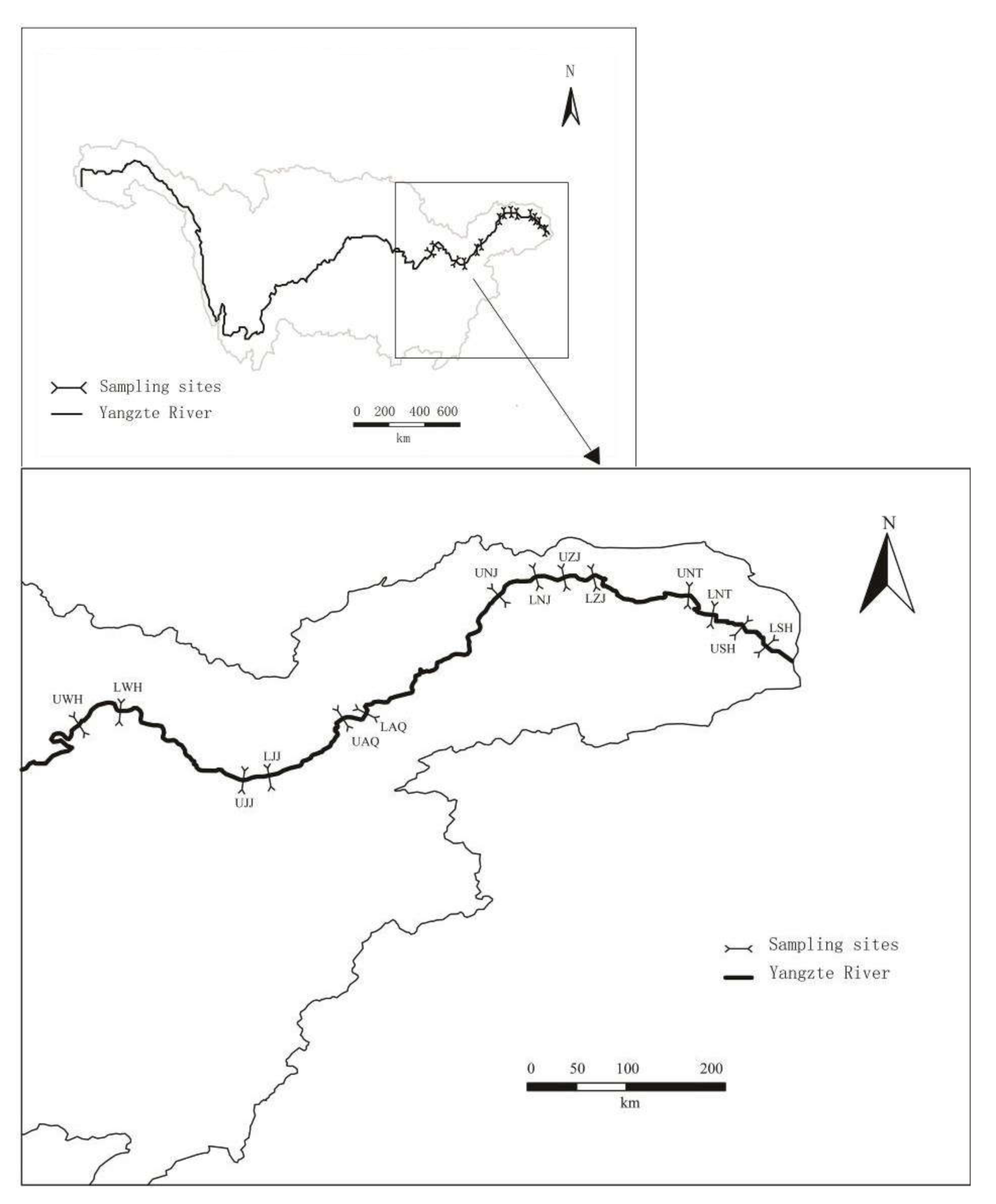

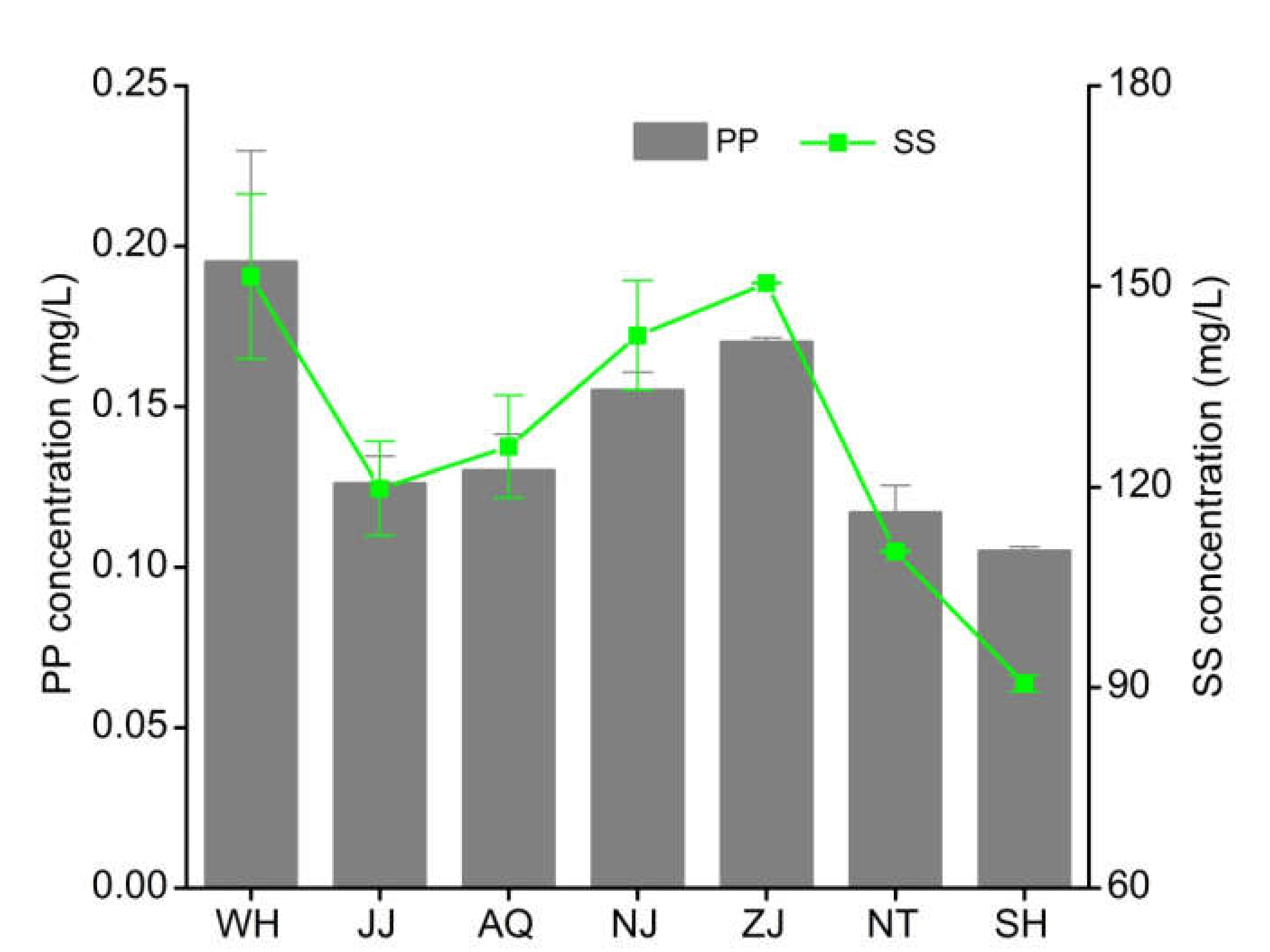
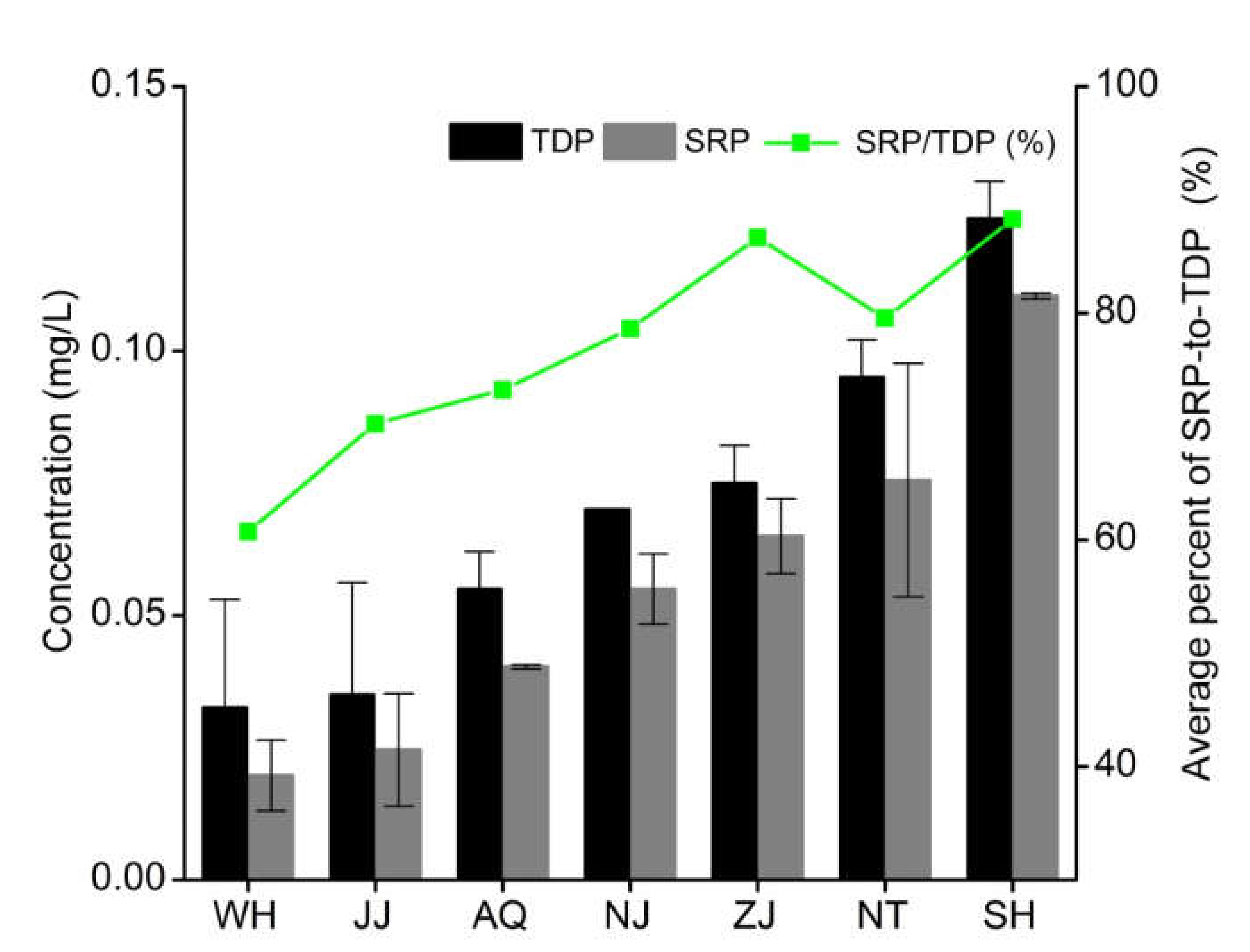
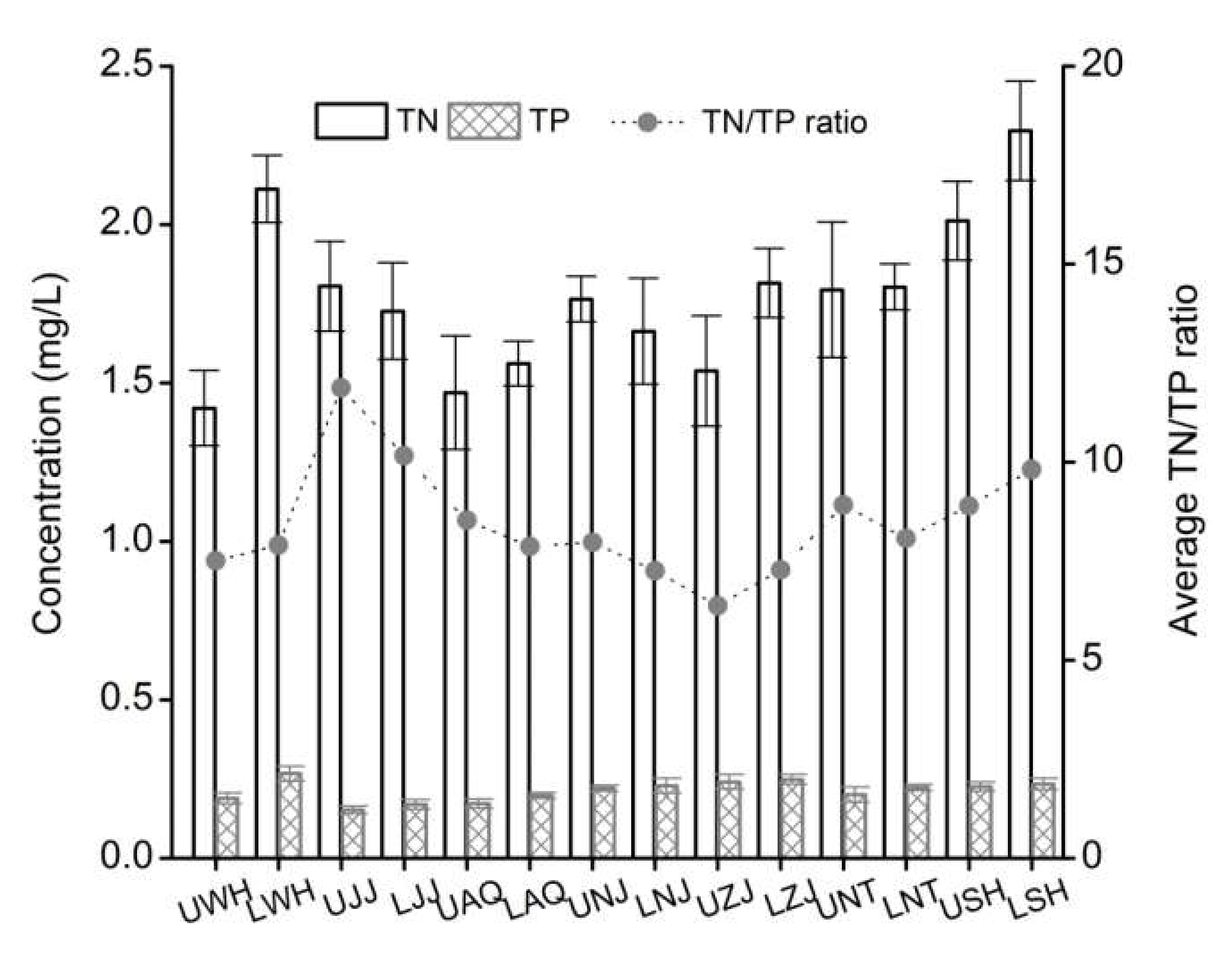
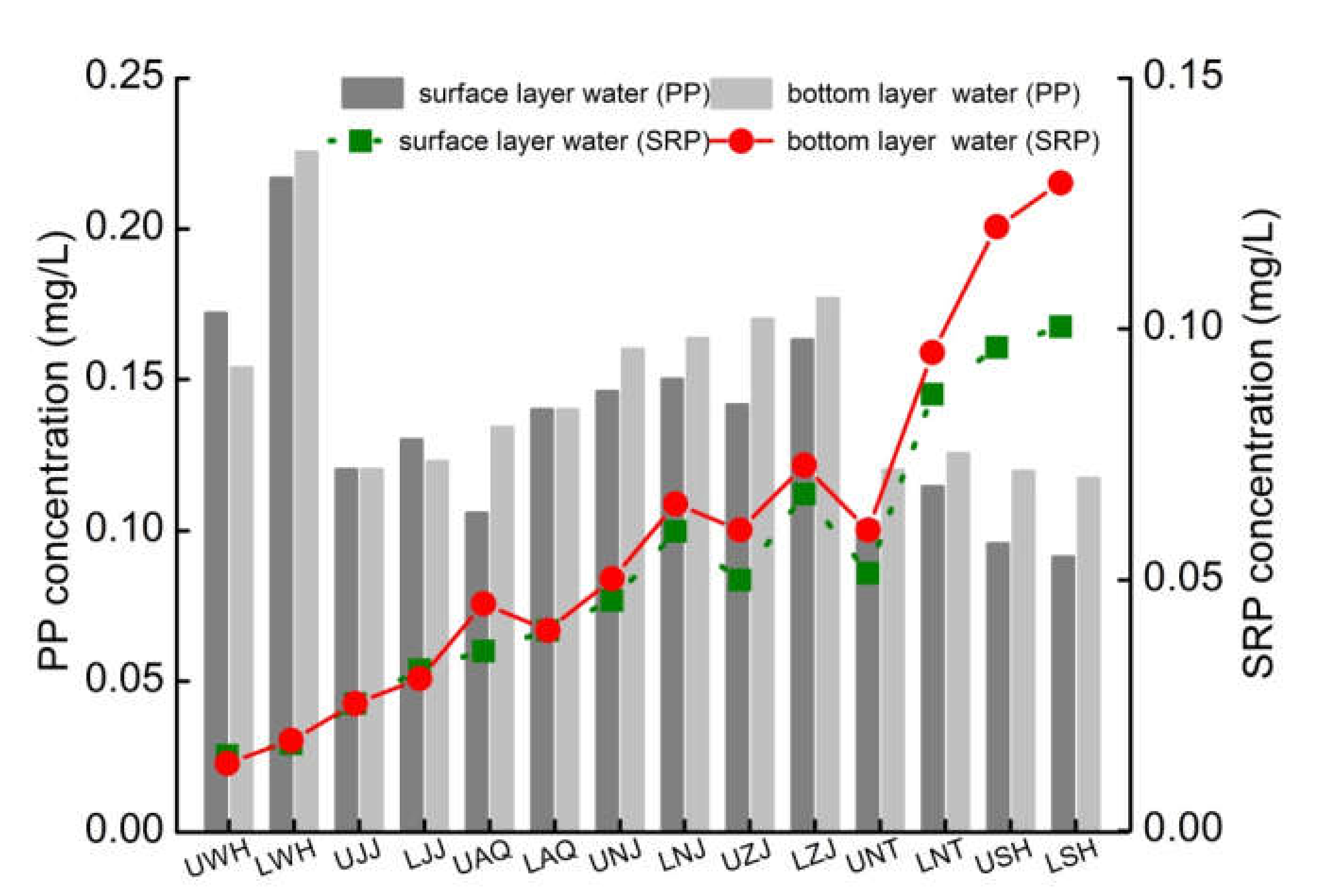
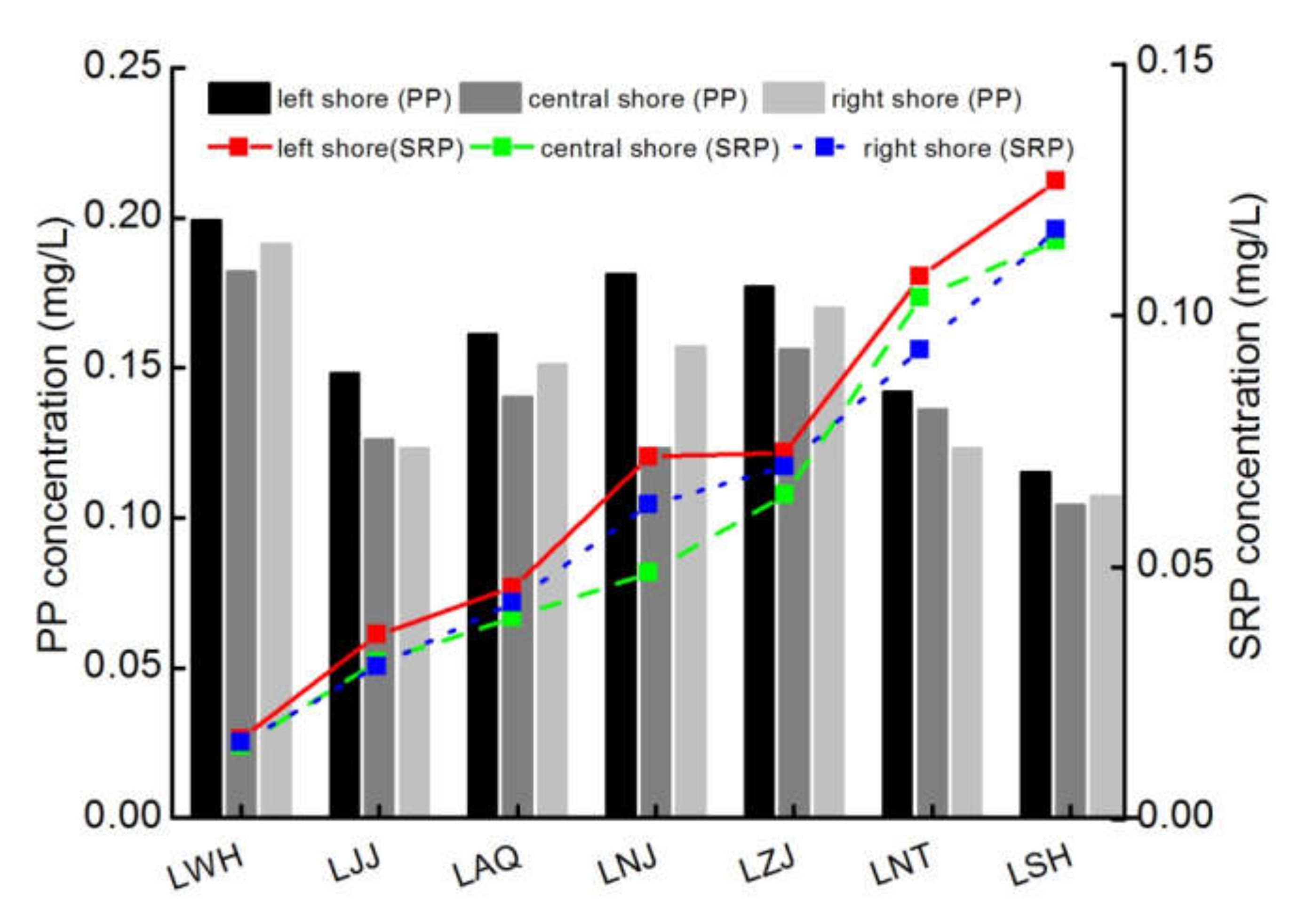
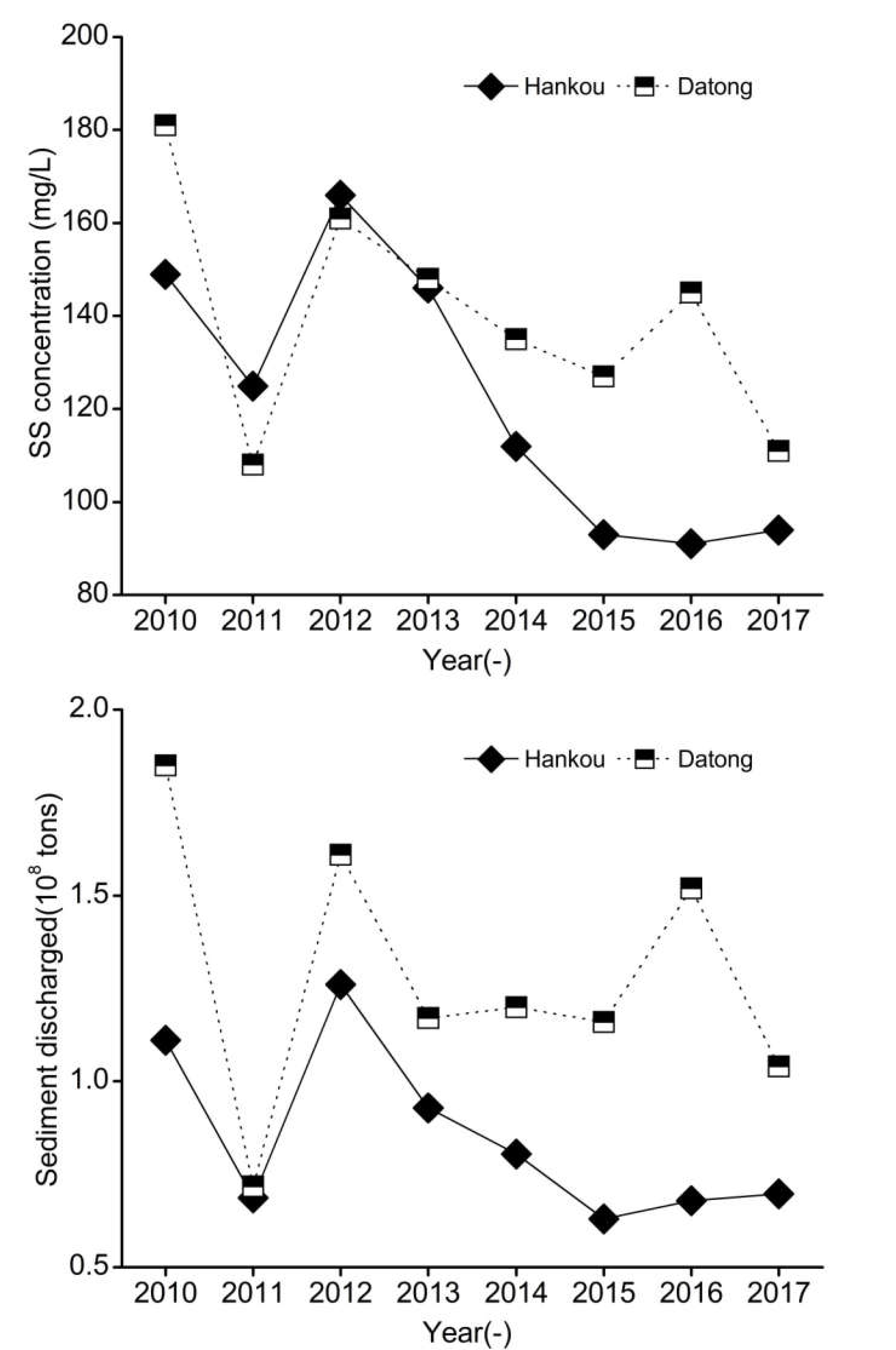
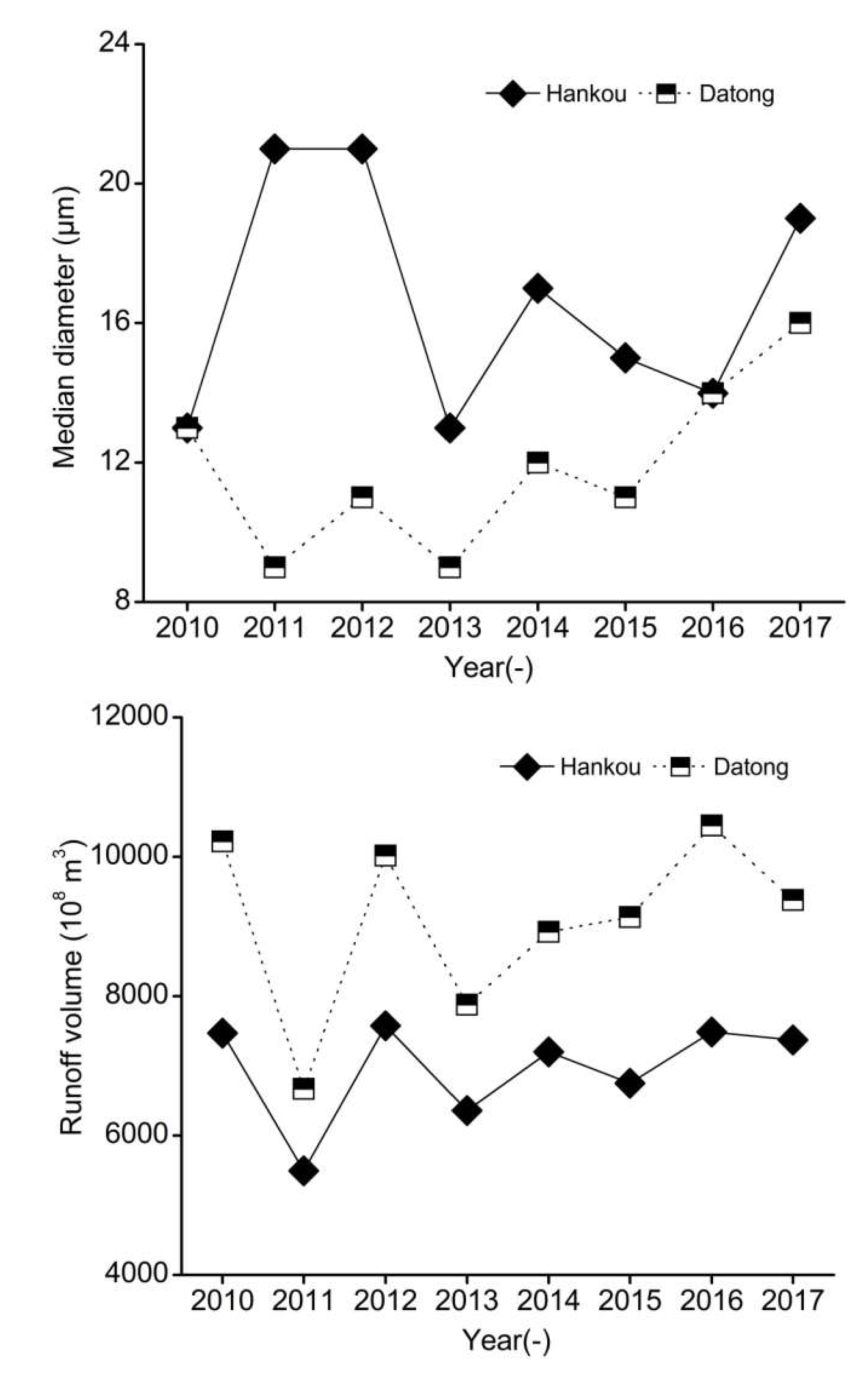
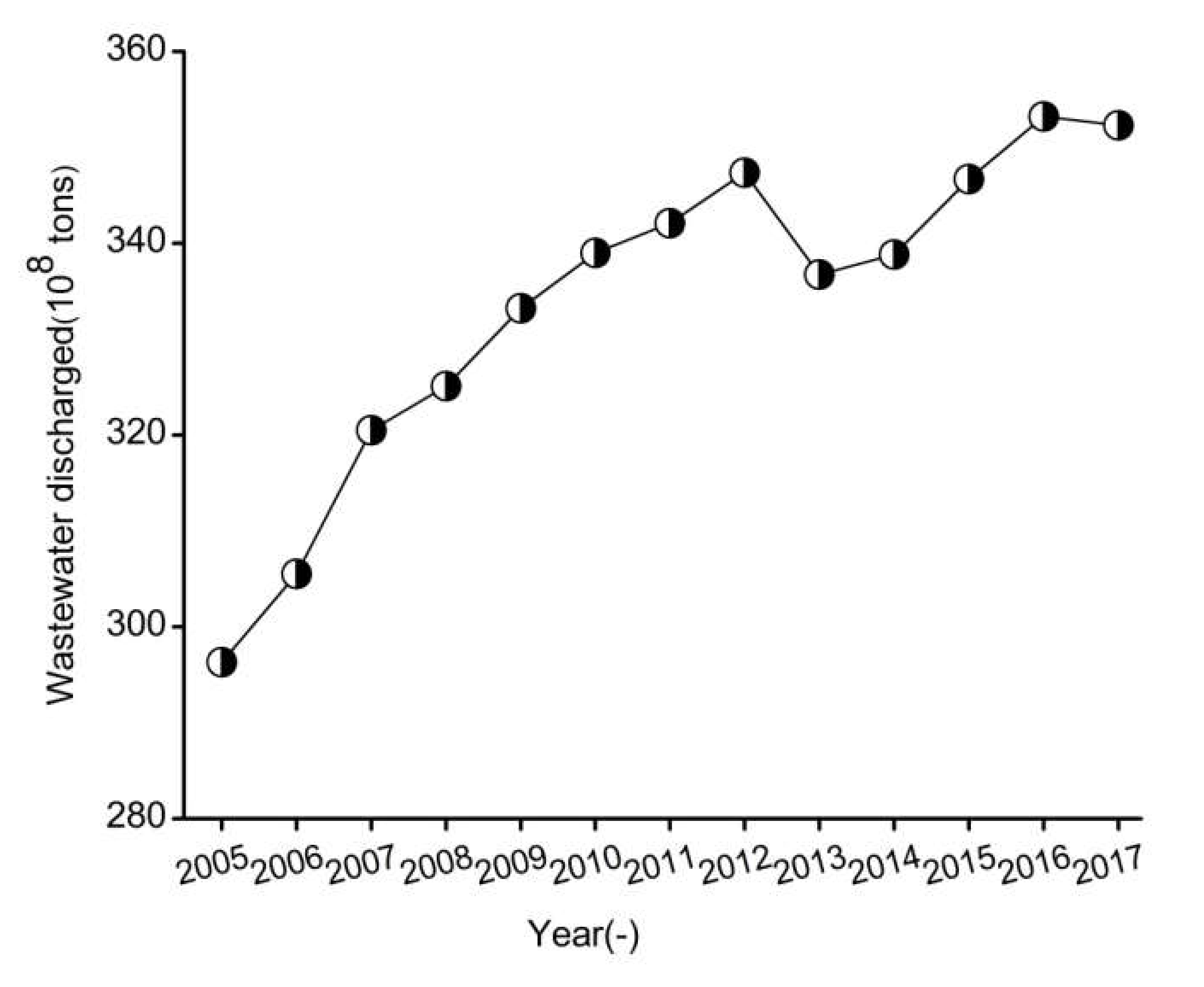
| Sampling Sites | Parameters | ||||||
|---|---|---|---|---|---|---|---|
| pH (-) | DO (mg/L) | TURB (NTU) | T (°C) | EC (µs/cm) | chl-a (μg/L) | ORP (mv) | |
| Wuhan (WH) | 7.98 ± 0.05 | 7.77 ± 0.17 | 30.88 ± 5.81 | 23.9 ± 0.4 | 228.0 ± 35.1 | 4.15 ± 0.44 | 533.4 ± 37.1 |
| Jiujiang (JJ) | 8.06 ± 0.05 | 6.85 ± 0.14 | 48.38 ± 7.41 | 23.0 ± 0.3 | 243.0 ± 43.2 | 3.63 ± 0.45 | 500.8 ± 37.6 |
| Anqing (AQ) | 8.08 ± 0.03 | 6.92 ± 0.19 | 59.55 ± 5.72 | 23.4 ± 0.6 | 210.3 ± 54.1 | 4.00 ± 0.18 | 496.4 ± 33.5 |
| NanJing (NJ) | 8.13 ± 0.01 | 7.21 ± 0.13 | 64.40 ± 7.72 | 23.7 ± 0.4 | 151.5 ± 45.7 | 3.88 ± 0.41 | 483.6 ± 47.6 |
| Zhengjiang (ZJ) | 8.00 ± 0.02 | 7.67 ± 0.24 | 60.98 ± 4.67 | 23.5 ± 0.1 | 170.0 ± 49.6 | 4.25 ± 0.19 | 451.5 ± 42.5 |
| Nantong (NT) | 8.04 ± 0.07 | 6.78 ± 0.21 | 59.13 ± 3.37 | 22.3 ± 0.4 | 228.5 ± 40.9 | 3.53 ± 0.28 | 414.1 ± 27.8 |
| Shanghai (SH) | 8.01 ± 0.13 | 6.22 ± 0.04 | 51.28 ± 2.58 | 21.8 ± 0.5 | 174.5 ± 47.8 | 3.15 ± 0.34 | 418.2 ± 35.3 |
| The Urban River Stretch | PP Concentration | SRP Concentration | ||
|---|---|---|---|---|
| The Upper Reach | The Lower Reach | The Upper Reach | The Lower Reach | |
| WH | 0.171 ± 0.012 | 0.220 ± 0.006 | 0.015 ± 0.001 | 0.024 ± 0.001 |
| JJ | 0.132 ± 0.002 | 0.120 ± 0.005 | 0.017 ± 0.001 | 0.032 ± 0.001 |
| AQ | 0.122 ± 0.009 | 0.138 ± 0.002 | 0.041 ± 0.006 | 0.040 ± 0.001 |
| NJ | 0.151 ± 0.007 | 0.159 ± 0.009 | 0.050 ± 0.003 | 0.060 ± 0.003 |
| ZJ | 0.171 ± 0.010 | 0.169 ± 0.011 | 0.060 ± 0.007 | 0.070 ± 0.004 |
| NT | 0.111 ± 0.007 | 0.123 ± 0.009 | 0.060 ± 0.006 | 0.091 ± 0.006 |
| SH | 0.106 ± 0.011 | 0.104 ± 0.013 | 0.111 ± 0.010 | 0.110 ± 0.013 |
© 2020 by the authors. Licensee MDPI, Basel, Switzerland. This article is an open access article distributed under the terms and conditions of the Creative Commons Attribution (CC BY) license (http://creativecommons.org/licenses/by/4.0/).
Share and Cite
Dong, L.; Lin, L.; Tang, X.; Huang, Z.; Zhao, L.; Wu, M.; Li, R. Distribution Characteristics and Spatial Differences of Phosphorus in the Main Stream of the Urban River Stretches of the Middle and Lower Reaches of the Yangtze River. Water 2020, 12, 910. https://doi.org/10.3390/w12030910
Dong L, Lin L, Tang X, Huang Z, Zhao L, Wu M, Li R. Distribution Characteristics and Spatial Differences of Phosphorus in the Main Stream of the Urban River Stretches of the Middle and Lower Reaches of the Yangtze River. Water. 2020; 12(3):910. https://doi.org/10.3390/w12030910
Chicago/Turabian StyleDong, Lei, Li Lin, Xianqiang Tang, Zhuo Huang, Liangyuan Zhao, Min Wu, and Rui Li. 2020. "Distribution Characteristics and Spatial Differences of Phosphorus in the Main Stream of the Urban River Stretches of the Middle and Lower Reaches of the Yangtze River" Water 12, no. 3: 910. https://doi.org/10.3390/w12030910
APA StyleDong, L., Lin, L., Tang, X., Huang, Z., Zhao, L., Wu, M., & Li, R. (2020). Distribution Characteristics and Spatial Differences of Phosphorus in the Main Stream of the Urban River Stretches of the Middle and Lower Reaches of the Yangtze River. Water, 12(3), 910. https://doi.org/10.3390/w12030910




